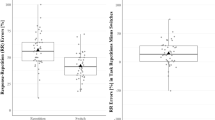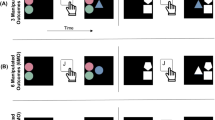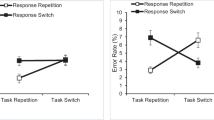Abstract
Repetition effects are often helpful in revealing information about mental structures and processes. Usually, positive effects have been observed when the stimuli or responses are repeated. However, in task shift studies it has also been found that response repetitions can produce negative effects if the task shifts. Although several mechanisms have been proposed to account for this interaction between task shifting and response repetition, many details remain open. Therefore, a series of four experiments was conducted to answer two questions. First, are motor responses necessary to produce response-related repetition effects, or is response activation sufficient? Second, does the risk of an accidental re-execution of the last response affect the repetition costs? The results show that response activation alone can produce repetition effects. Furthermore, the risk of accidental response re-execution largely modulates these effects.






Similar content being viewed by others
Notes
Our proportion of single stimulus trials (50%) is rather small compared with other change task studies, where they were usually within a range of 75 to 90% (Logan, 1994). Nevertheless, we used this smaller proportion in order to keep the experiment within reasonable temporal limits.
Compared with the previous change task studies, we used a somewhat different terminology here. Instead of “signal inhibit trials”, we denote the trials in which participants did not respond to S1 but only responded to S2 “successful change trials.” Furthermore, instead of “signal respond trials” for trials in which participants erroneously responded to S1 and S2, we used “accidental dual task trials” here. The reasons for this adaptation are that (a) the latter terms are only descriptive and do not already imply theoretical connotations that may interfere with the concepts relevant to the purposes of this study, and (b) are more explicit regarding the cases they designate.
Notice that the number of observations per condition were unequal due to the fact that the participants responded on average only to about 17% of the S1 at the SOA of 50 ms, but to about 53% at the SOA of 350 ms. Consequently, the mean RTs for each participant and condition are based on unequal numbers of trials. However, since all conditions comprised at least eight valid trials, which were considered sufficient to estimate the respective mean response times, we did not apply special statistical procedures.
We did not analyze the R1 data in accidental dual task trials, because they are considered as erroneous responses here.
Compared with the previous change task studies, we used somewhat different terminology here. Instead of “signal inhibit trials,” we denote the trials in which participants did not respond to S1 but only responded to S2 “successful change trials.” Furthermore, instead of “signal respond trials” for trials in which participants erroneously responded to S1 and S2, we used “accidental dual task trials” here. The reasons for this adaptation are that (a) the latter terms are only descriptive and do not already imply theoretical connotations that may interfere with the concepts relevant to the purposes of this study, and (b) are more explicit regarding the cases they designate.
We could speculate that index/middle finger or inner/outer keys could also have served as response categories (Logan & Schulkind, 2000). However, with these categories the mappings between stimulus categories and response categories are not spatially consistent across hands. Since spatial consistency between mappings plays an important role (Duncan, 1979), we assumed that the participants would choose spatial response categories. This assumption was confirmed by our data.
References
Bertelson, P. (1963). S-R relationships and RT to new vs. repeated signals in a send task. Journal of Experimental Psychology, 65, 478–484.
Bertelson, P. (1965). Serial choice reaction-time as a function of response versus signal-and-response repetition. Nature, 206, 217–218.
Braver, T. S., Reynolds, J. R., & Donaldson, D. I. (2003). Neural mechanisms of transient and sustained cognitive control during task switching. Neuron, 39, 713–726.
Campbell, K. C., & Proctor, R. W. (1993). Repetition effects with categorizable stimulus and response sets. Journal of Experimental Psychology: Learning, Memory, and Cognition, 19, 1345–1362.
Duncan, J. (1979). Divided attention: The whole is more than the sum of its parts. Journal of Experimental Psychology: Human Perception and Performance, 5, 216–228.
Hommel, B. (1998a). Automatic stimulus-response translation in dual-task performance. Journal of Experimental Psychology: Human Perception and Performance, 24, 1368–1384.
Hommel, B. (1998b). Event files: Evidence for automatic integration of stimulus-response episodes. Visual Cognition, 5, 183–216.
Hommel, B., Müsseler, J., Aschersleben, G., & Prinz, W. (2001). The Theory of Event Coding (TEC): A framework for perception and action planning. Behavioral and Brain Sciences, 24, 849–878.
Hübner, R., Futterer, T., & Steinhauser, M. (2001). On attentional control as source of residual shift costs: Evidence from two-component task shifts. Journal of Experimental Psychology: Learning, Memory, and Cognition, 27, 640–653.
Kleinsorge, T. (1999). Response repetition benefits and costs. Acta Psychologica, 103, 295–310.
Kleinsorge, T., & Gajewski, P. D. (2004). Preparation for a forthcoming task is sufficient to produce subsequent shift costs. Psychonomic Bulletin & Review, 11, 302–306.
Kleinsorge, T., & Heuer, H. (1999). Hierarchical switching in a multi-dimensional task space. Psychological Research, 62, 300–312.
Lien, M. C., Schweickert, R., & Proctor, R. W. (2003). Task switching and response correspondence in the psychological refractory period paradigm. Journal of Experimental Psychology: Human Perception and Performance, 29, 692–712.
Logan, G. D. (1985). On the ability to inhibit simple thoughts and actions. II. Stop-signal studies of repetition priming. Journal of Experimental Psychology: Learning, Memory and Cognition, 11, 675–691.
Logan, G. D. (1994). On the ability to inhibit thought and action. In D. Dagenbach & T. H. Carr (Eds.), Inhibitory processes in attention, memory, and language (pp. 188–239). San Diego: Academic Press.
Logan, G. D., & Burkell, J. (1986). Dependence and independence in responding to double stimulation: A comparison of stop, change, and dual-task paradigms. Journal of Experimental Psychology: Human Perception and Performance, 12, 549–563.
Logan, G. D., & Schulkind, M. D. (2000). Parallel memory retrieval in dual-task situations. I. Semantic memory. Journal of Experimental Psychology: Human Perception and Performance, 26, 1072–1090.
Meiran, N. (2000a). Modeling cognitive control in task-switching. Psychological Research, 63, 234–249.
Meiran, N. (2000b). Reconfiguration of stimulus task sets and response task sets during task switching. In S. Monsell, & J. Driver (Eds.), Attention and performance XVIII: Control of cognitive processes (pp. 377–399). Cambridge, MA: MIT Press.
Meiran, N. (2005). Task rule congruency and Simon-like effects in switching between spatial tasks. Quarterly Journal of Experimental Psychology , 58A, 1023–1041.
Meiran, N., & Gotler, A. (2001). Modelling cognitive control in task switching and ageing. European Journal of Cognitive Psychology, 13, 165–186.
Pashler, H. (1984). Processing stages in overlapping tasks: Evidence for a central bottleneck. Journal of Experimental Psychology: Human Perception and Performance, 10, 358–377.
Pashler, H., & Baylis, G. (1991). Procedural learning. II. Intertrial repetition effects in speeded-choice tasks. Journal of Experimental Psychology: Learning, Memory, and Cognition, 17, 33–48.
Peeke, S. C., & Stone, G. C. (1972). Sequential effects in two- and four-choice tasks. Journal of Experimental Psychology, 92, 111–116.
Quinlan, P. T. (1999). Sequential effects in auditory choice reaction time tasks. Psychonomic Bulletin & Review, 6, 297–303.
Rabbitt, P. M. A. (1968). Repetition effects and signal classification strategies in serial choice-response tasks. Quarterly Journal of Experimental Psychology, 20A, 232–240.
Rogers, R. D., & Monsell, S. (1995). Costs of a predictable switch between simple cognitive tasks. Journal of Experimental Psychology: General, 124, 207–231.
Schuch, S., & Koch, I. (2003). The role of response selection for inhibition of task sets in task shifting. Journal of Experimental Psychology: Human Perception and Performance, 29, 92–105.
Schuch, S., & Koch, I. (2004). The costs of changing the representation of action: Response repetition and response-response compatibility in dual tasks. Journal of Experimental Psychology: Human Perception and Performance, 30, 566–582.
Smith, M. C. (1968). Repetition effect and short-term memory. Journal of Experimental Psychology, 77, 435–439.
Waszak, F., Hommel, B., & Allport, A. (2003). Task-switching and long-term priming: Role of episodic S-R bindings in task-shift costs. Cognitive Psychology, 46, 361–413.
Welford, A. T. (1952). The ‘psychological refractory period’ and the timing of high-speed performance—a review and a theory. British Journal of Psychology, 43, 2–19.
Acknowledgements
We thank Thomas Kleinsorge, Nachshon Meiran, and Stefanie Schuch for their helpful comments on an earlier version of this paper. This research was supported by a grant from the Universität Konstanz, Germany.
Author information
Authors and Affiliations
Corresponding author
Rights and permissions
About this article
Cite this article
Hübner, R., Druey, M.D. Response execution, selection, or activation: What is sufficient for response-related repetition effects under task shifting?. Psychological Research 70, 245–261 (2006). https://doi.org/10.1007/s00426-005-0219-8
Received:
Accepted:
Published:
Issue Date:
DOI: https://doi.org/10.1007/s00426-005-0219-8




